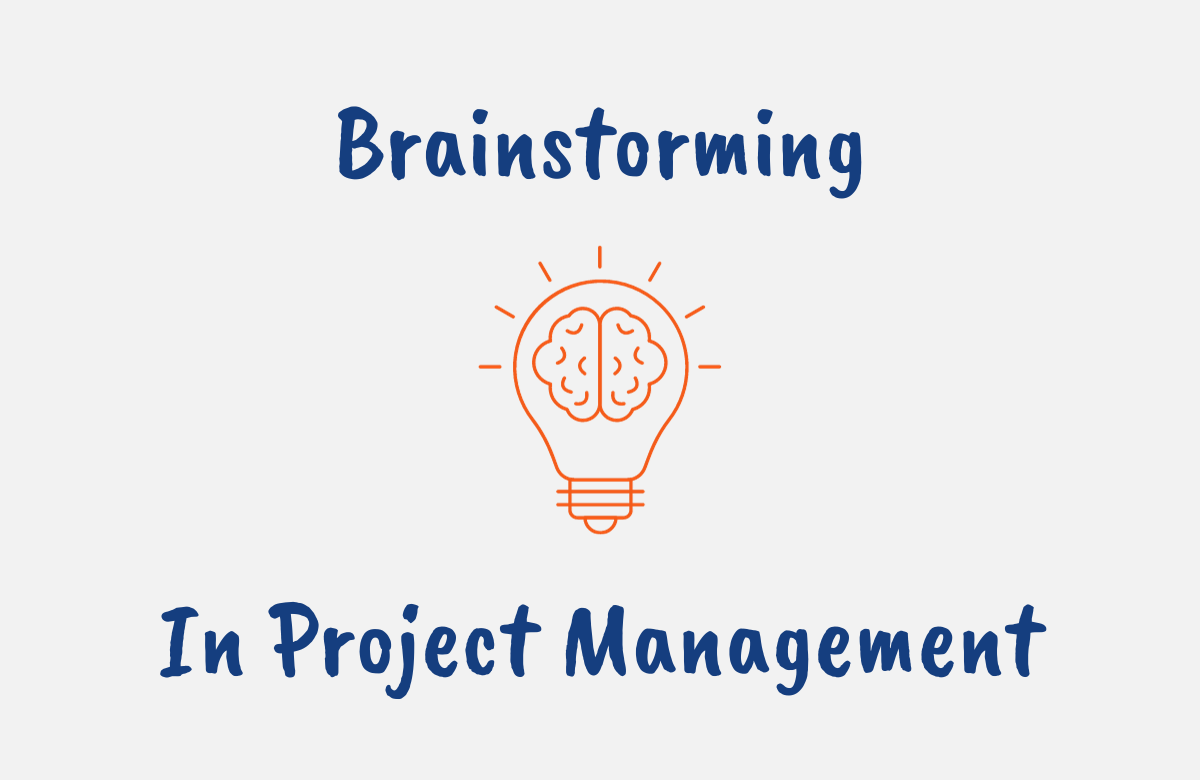As a project manager or Business Analyst, you need to elicit requirements from your stakeholders to understand what they want in order to deliver value to them. One of the most effective ways to do this is by brainstorming.
Having facilitated countless workshops, brainstorming remains my go-to technique. In this article, we’ll explore what brainstorming in project management is all about, different brainstorming approaches, and how to use it effectively.
If you are preparing for the PMP certification exam, brainstorming is one of the most common techniques among the project management process ITTOs. Thus, we’ll also cover brainstorming PMP exam tips.
What is Brainstorming in Project Management?
Brainstorming is a creative group technique used in project management to generate a broad set of solutions or ideas to a defined problem or objective. It comprises 2 parts: idea generation and analysis.
It involves a facilitated discussion where team members are encouraged to openly share spontaneous thoughts and build on each other’s suggestions.
The key premise is that a group can generate better quality ideas through collective knowledge sharing than by individuals alone.
A brainstorming session is typically led by the project manager or facilitator who introduces the problem statement, and sets some basic ground rules (such as no criticism of ideas during the ideation phase), while a recorder captures all suggestions.
Once a healthy list is built, the ideas can be analyzed for feasibility and narrowed down to select the optimal solutions.
Brainstorming helps break down assumptions, leverage diversity of thought, and arrive at innovative approaches.
It is a valuable technique in project management during planning activities like creating the Project Charter, gathering requirements, developing the risk response plan, and lessons learned sessions.

Types of Brainstorming Techniques in Project Management
There are several structured approaches to brainstorming in project management that you can utilize depending on which is best aligned with your session goals and team dynamics:
- Traditional Brainstorming: This is an unstructured approach where the facilitator introduces a problem and the group starts suggesting solutions conversationally. This way, ideas build rapidly with no particular order.
- Round Robin: Each person takes turns sharing an idea one by one. This prevents vocal participants from dominating and lets introverts contribute.
- Brainwriting: Instead of verbalizing ideas, individuals silently write down ideas first which avoids critiquing. Papers are then shared for group analysis.
- Nominal Group Technique: After brainwriting, each idea is discussed before participants privately rank/vote on them. The highest-rated options get further analyzed for final selection.
- Reverse Brainstorming: The group starts by suggesting wildly impractical or bad ideas first. This frees people to think unconventionally and may spark creative solutions.
- Individual Brainstorming: Rather than a group discussion, members independently brainstorm on post-its first and then share. This technique removes social inhibitions.
- Rolestorming: Members take on various personas/roles and brainstorm from those different viewpoints to reduce bias.
- Online Brainstorming: Using digital whiteboards and virtual stickies to enable remote teams to brainstorm effectively.

Importance of Brainstorming in Project Management
Brainstorming serves many crucial purposes in project management:
Generates Innovative Solutions
Brainstorming brings together different perspectives to develop creative solutions to complex project problems. Individuals often get stuck in certain mindsets.
Brainstorming breaks people out of their typical thought patterns, allowing more innovative ideas to emerge. The spontaneity of sharing raw ideas opens up new possibilities.
Leverages Collective Expertise
Brainstorming enables project teams to leverage their collective expertise as no single person has all the answers.
People contribute their domain knowledge, experience, and diversity of insights to build upon each other’s ideas.
Identifies Potential Risks
During brainstorming in project management, teams can identify risks, challenges, and impacts related to different solutions.
By hashing out ideas in a group, more risks can be highlighted upfront before major problems develop.
Builds Team Synergy
The collaboration of brainstorming brings people together. Engaging in creative ideation builds team spirit and relationships as people feel valued by contributing thoughts and the synergy translates to better project execution.
Fosters Creative Thinking
Brainstorming provides space for creative thinking to flourish. People can share ideas outside the box without fear of judgment which spurs innovation and allows unique concepts to emerge.
Develops Holistic Strategies
With diverse input, brainstorming allows more holistic project plans and strategies to take shape.
Solutions will suit a broader range of stakeholders when multiple voices are included.
Gains Commitment
When people participate in brainstorming, they gain more ownership of the outcomes driving greater commitment during implementation as their ideas are baked into the plans.

How to Use Brainstorming in Project Management
Effective brainstorming in project management involves two key phases – ideation and analysis.
Ideation Phase
- Set Objectives: Define the specific problem or opportunity you want ideas on, and ensure everyone understands the scope.
- Schedule Session: Pick a time and book a meeting room for 30-60 minutes. Invite a diverse group of 6-12 participants.
- Select Format: Choose a structured approach like traditional brainstorming or nominal group technique.
- Explain Ground Rules: Cover guidelines like no judging ideas and building on suggestions.
- Gather Supplies: Have flip charts, post-its, and markers to capture ideas.
- Kick Off with Energy: Get creative juices flowing with an icebreaker activity.
- Facilitate Discussion: Keep ideas flowing. Draw out quiet people. Record all suggestions visually.
- Close Ideation: Wrap up when ideas start slowing, and thank everyone for contributing.
Analysis Phase
- Review Ideas: Organize and analyze the ideas generated and identify duplicates.
- Rate Ideas: Have participants use dot voting to rate the strongest ideas.
- Select Ideas: Based on voting, select the top ideas to further develop and prototype.
- Communicate Next Steps: Inform participants what concepts you’ll be pursuing and seek final input.
Advantages of Brainstorming in Project Management
Applying brainstorming techniques provides several key benefits for projects:
- Fosters Innovation: It removes constraints to spark creative solutions as sometimes the least obvious ideas can be the most powerful.
- Saves Time: Brainstorming rapidly generates many ideas to evaluate thus accelerating analysis and decision-making.
- Increases Engagement: The collaborative approach makes sessions fun and builds team spirit.
- Reduces Groupthink: The diversity of input mitigates bias of individuals or dominant views.
- Leverages Expertise: It draws on knowledge, skills, and experiences across all participants.
- Uncovers Risks: It surfaces potential challenges and unintended consequences.
- Promotes Consensus: Stakeholders gain ownership in outcomes when involved.
- Improves Communication: Open sharing of ideas builds connections.
- Boosts morale: People feel valued by contributing thoughts. This helps in energizing the team.

Challenges with Brainstorming in Project Management
While brainstorming in project management is very useful, it has its challenges which can make its output not as productive as needed.
Personality Dynamics
Brainstorming brings together people with different personalities and communication styles and this diversity can be challenging to manage as some may dominate while others hold back ideas.
As a facilitator, you need relevant skills to draw out introverts and control oversharers.
Judgment of Ideas
A big pitfall is when participants start critiquing and judging early on, which stifles creativity and results in flared-up egos.
If you are facilitating, then it’s important to firmly establish no analyzing during ideation and remind people to stay open and build on others’ ideas.
Lack of Focus
Without clear goals, brainstorming discussions can easily veer off track and participants may go off on tangents.
Strong facilitation is required to redirect the conversation and keep sessions focused.
Groupthink
At times, group dynamics lead to convergent thinking where people simply agree with or echo the first few ideas. This “groupthink” suppresses further creativity.
Logistics
Another challenge of brainstorming is the difficulty in getting decision-makers together in the same room at the same time for quality discussion.
There needs to be a lot of flexibility in scheduling sessions when key people are available.
Analysis Paralysis
Brainstorming produces a wealth of ideas, which can lead to over-analysis rather than taking action.
When facilitating, ensure that you drive the team to prioritize concepts and make timely decisions.
Lack of Closure
Sessions sometimes end without clear direction on what ideas will actually be pursued.
A key step in ending sessions involves closing the loop and gaining alignment on the next steps.

Brainstorming PMP Exam Tips
If you are preparing for the PMP exam, you must know the inputs, tools, techniques, and outputs (ITTOs) for various project management processes.
Per the PMBOK Guide, brainstorming is an important technique that can be utilized in various processes.
For the exam, know the various processes where facilitating brainstorming helps develop project management plans:
- Develop Project Charter: Brainstorming with sponsors and key stakeholders generates ideas to define the project objectives, scope, risks, assumptions, and constraints.
- Plan Scope Management: The project team can brainstorm to determine key deliverables, acceptance criteria, and scope management approach.
- Collect Requirements: Brainstorming helps elicit detailed requirements from stakeholders.
- Define Scope: Team brainstorming assists in developing the WBS and project scope statement.
- Plan Schedule Management: Brainstorm methods to sequence activities, estimate durations, and optimize the schedule.
- Estimate Costs: Generate cost estimate ideas through brainstorming.
- Identify Risks: Brainstorm session to identify threats and opportunities.
- Plan Risk Responses: Ideate risk mitigation strategies.
- Acquire Resources: Brainstorm options to get optimal team members and suppliers.
- Plan Communications: Determine communication channels, formats, and strategies.
- Develop Team: Generate ideas to build a collaborative team environment.
- Plan Stakeholder Engagement: Brainstorm approaches to manage stakeholders.
- Close Project: Ideate lessons learned, handover tactics, and administrative closure steps.
Summary
When managing projects, brainstorming is a pivotal technique to master. Following a structured facilitation process enables teams to collaboratively ideate solutions and accelerate decision-making.
Brainstorming fosters innovation, surfaces risks, builds alignment, and boosts morale through inclusive creative thinking.
Learn how to optimize sessions by defining goals, establishing ground rules, managing dynamics, and analyzing ideas.
FAQs
How Long Should a Brainstorming Session Last?
A brainstorming session should ideally last between 15 to 45 minutes. This timeframe promotes productive idea generation, allows for diverse input, and helps avoid fatigue or loss of focus.
However, the duration might vary based on the complexity of the topic or the size of the group.
What is the Golden Rule in Brainstorming?
In brainstorming, the Golden Rule is to “defer judgment.” This means allowing all ideas, regardless of their perceived quality or feasibility, to be expressed freely without immediate critique.
It encourages open communication, fosters creativity, and leads to a diverse range of solutions.
How is Brainstorming Beneficial During the Planning Process?
Brainstorming during the planning process encourages creative thinking, promotes collaboration, and generates a variety of ideas.
It helps in identifying potential solutions, broadens perspectives, and can reveal innovative approaches to challenges. This enhances the quality and comprehensiveness of the final plan.
Who Facilitates a Brainstorming Session?
A brainstorming session is typically facilitated by a team leader, project manager, or a designated facilitator.
Their role is to guide the discussion, ensure all participants contribute, manage time effectively, and foster a non-judgmental environment conducive to free-flowing idea generation.





